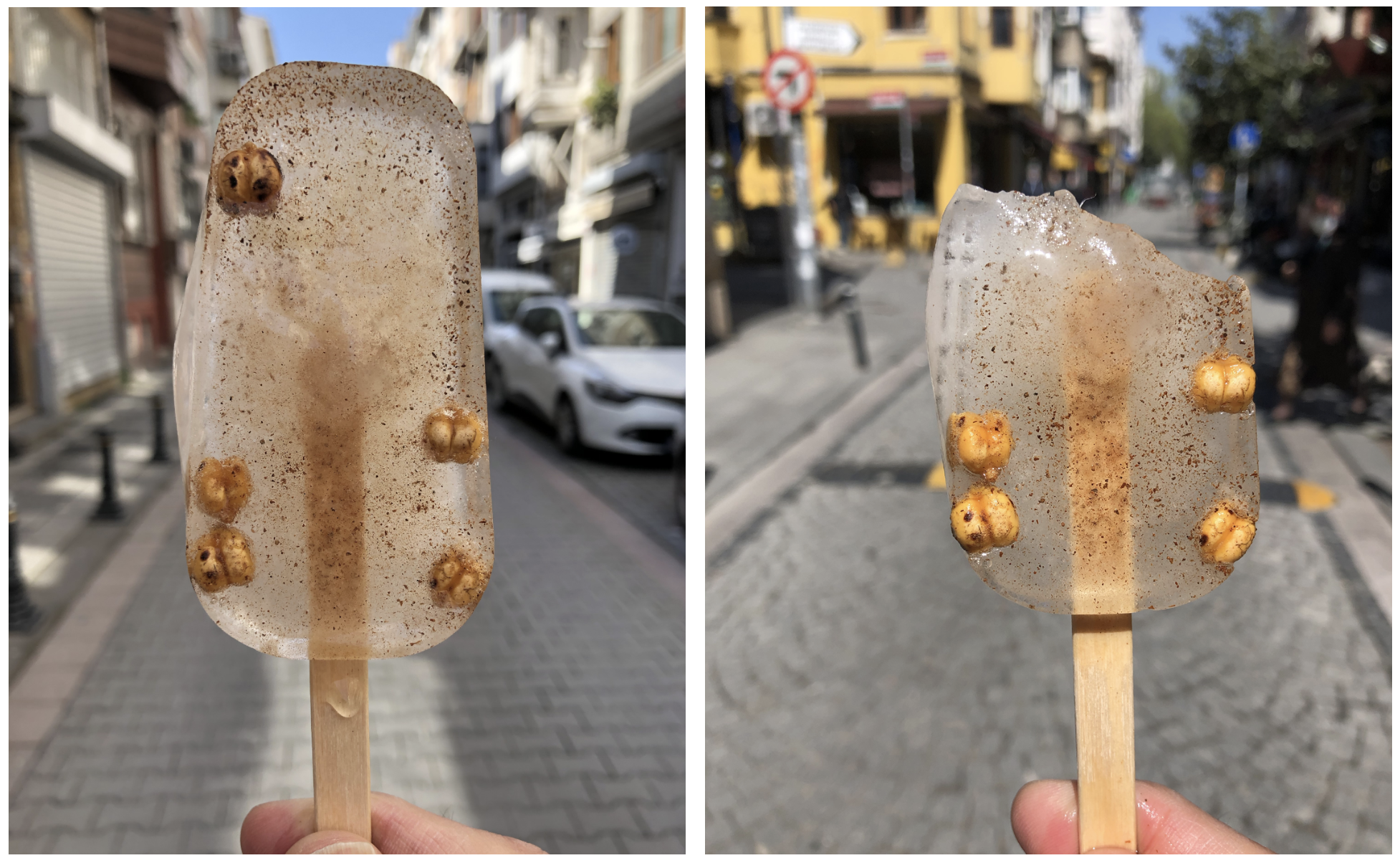The Impossible Fruit
The impossible fruit is a frozen architecture for microorganisms. A new “bostan” where they can meet each other or other organisms.
Here, we would like to show you the steps to hydrate, Weissella paramesenteroides and Staphylococcus carnosus to make Boza-flavored popsicles. In addition to these two organisms which came with your microbial kit, we will also add live cultures coming from a fermented Boza drink to create a more complex cosmopolitan environment in which the two wild organisms can meet Boza cultures coming from a lab.
Our design has three steps:
Organism Hydration
Organism and flavor Encapsulation
Popsicle Design
Set-up
We need the following ingredients and tools to realize our design:
Sodium Alginate and Calcium Chloride. You can order it from Modernist Kitchen.
Dried Organisms (2 x 10g sachets). Please contact us for how to get the organisms.
Boza, chickpeas, cinnamon
Distilled water.
Popsicle mold and sticks.
3 small measuring cups
Measuring tools, tweezers, strainer
Scale
60ml syringes and pipettes
Organism Hydration
Our organisms come in two sachets in dried form. Here, we mark Weisella with white and Staphylococcus with blue stickers.
Take 1/4 spoon full of organisms from each sachet and put them into two glass cups
Measure 40 g of water and mix it with the organisms
2. Encapsulation
This process is for encapsulating organisms into a solid spherical form so they can be made visible throughout the design. We will be able to place organisms into specific locations and make sure that they can interface with each other.
Spherification relies on the principle that any liquid content that is mixed with Sodium Alginate will go to a chemical polymerization process when it is dropped into a Calcium solution. So after we re-hydrate our organisms, we will add Sodium Alginate to the mix and create a solution that can be dropped or extruded using a syringe or dropper.
After the bath, we will quickly pick the encapsulations and dry them for further use.
For more information specification you can watch this video.
Preparing the Calcium Bath
We start with preparing the Calcium bath.
Take 1 table spoon full of Calcium Chloride and mix it with one cup of distilled water.
Preparing the Sodium Alginate Solutions
We will prepare a Sodium Alginate solution for each organism (payload) we would like to encapsulate.
Measure 5 g of Sodium Alginate using the scale in separate cups.
Mix the Sodium Alginate into cups with hydrated organisms. Use a hand blender to mix them thoroughly.
Add 40 g more distilled water so each cup gets half full. Blend the mixture more.
Making Encapsulations with Weisella and Staph
Use a 60ml syringe to draw the contents of your cup and dispose it into the Calcium bath.
Make sure that you form discrete droplets. If you press the plunger too long you will make longer extruded forms.
Pick the encapsulations with a pair of tweezers and place them on a dry surface. You can also collect them into a strainer and dry them before placing onto the surface.
Repeat the same process for the other organism and create at least 10-20 encapsulations for each species.
Making Encapsulations with Boza
We will also encapsulate the cultures inside Boza using a similar method. We will scoop 1-1.5 tablespoon of Boza and mix it with the Sodium Alginate solution. After blending it with, we will use a syringe to create the spheres by dropping them into the Calcium bath.
3. Popsicle Design
We will use a silicone mold to design the popsicles. Our three-Popsicle mold will allow us to design three different architectures where we will have the following combination of microbial cultures.
Only Weisella
Staph + Weisella
Staph + Weisella + Boza
Insert the popsicle sticks to cover the holes in the silicone mold. Use filtered tap water to fill all three sections. Regular tap water may contain high amounts of chlorine or antimicrobial agents that may harm the organisms.
Pick the encapsulations with the tweezer and place them one by one to the different compartments of the mold.
The different encapsulations are visible based on their shape and density. We can place all cultures at different proximities and allow them to interface with each other. In the picture, the boza encapsulations appear with more distinctly due to their unique yellowish color.
Boza is traditionally served with roasted chickpeas and cinnamon. We follow the tradition and sprinkled the chickpeas and cinnamon to our design.
The final design is ready to be frozen. We place them in a regular fridge for 24hrs. During that time, we don’t expect the organisms interact with each other as the cold fridge environment will significantly lower their metabolic activities. We expect them to mix inside the body after we at them.
24 hrs later
The popsicles can be removed from their mold and will be ready to be served.
The popsicles are ready to be consumed at your leisure. With each bite, we send some Weisella and Staph to our gut. A new place where they may or may not be welcomed by local organisms. They may simply pass through our body and mix to the water, air, and soil of Istanbul. Some may stick around and be part of the local microbiota. We would like to imagine that The Impossible Fruit is where these unlikely encounters become a possibility.
We thank our project partner Nadas Istanbul for letting us use their kitchen in Degirmendere, Kadiköy and Ahu Toksoz for patiently modeling during the making of the “impossible fruits”.
Please write to orkan@design.bio if you are interested in receiving our microbial kit for exploring new dishes with Weisella and Staph






















